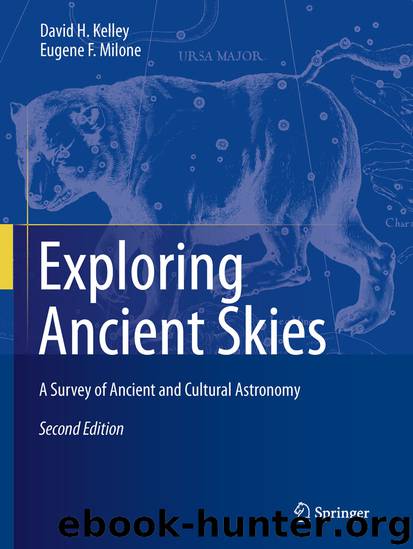Exploring Ancient Skies by David H. Kelley & Eugene F. Milone

Author:David H. Kelley & Eugene F. Milone
Language: eng
Format: epub
Publisher: Springer New York, New York, NY
9.4 Tibet
Tibet lies in the highest mountainous region of the world between the Indian subcontinent and the deserts of central Asia. Although the dominant cultural relationships have been with India, there have been frequent Chinese intrusions.
Christopher Beckwith (1987/1993) is the first “western” scholar to treat central Asian politics during the time of the great Turkish and Mongol empires from a Tibetan viewpoint. Tibetan historical sources have been little known to western scholars and frequently denigrated, especially when they seemed to contradict Chinese documents. Beckwith’s analyses make such positions untenable in principle and frequently in detail. Tibet’s central role as an intermediary between China, India, and the Turko-Mongol cultures is now much clearer. There is a statement in the 10th-century Chinese Tang Annals that Tibetans descended from the Qiang people, who are mentioned as early as 200 b.c. (Chan 1994, pp. 26–35). Over much of its history, Tibet has had a theocratic government, drawn from one of its many monasteries, and often it acted at least quasi-independently under the formal control of Mongolian or Chinese emperors. Buddhism is said to have been introduced from above by scriptures falling from the sky during the reign of the (legendary) 28th king, Lhatori. Although occasionally suppressed, Buddhism has been the principal religion of the country throughout its history, and even today, as the “Xizang Autonomous Region” of the People’s Republic of China. Tibetan Buddhism derived mainly from two sources: the Mahayana system, itself having developed from a 1st-century form of Buddhism known as Theravada, and Tantrism. Mahayana Buddhism emphasizes enlightenment not for the benefit of the individual pursuing it but for the salvation of all beings; the true spiritual ideal is the bodhisattva, who defers the achievment of nirvana to prevent the sufferings of others. The 24 bodhisattvas of some forms of Tibetan Buddhism (Bryant 1992, p. 202) show parallels in their cosmic role with the 24 Tirthakaras of the Jains and, like the Tirthakaras, are sometimes called “conquerers.” Tantrism was known in both Hindu and Jain communities. Tantrism is less doctrinal and emphasizes meditation with yoga practices; the achievement of enlightenment requires experience as well as pure meditation (Gombrich 1984, p. 14). There have been five main sects of Buddhism in Tibet: the Nyingma, Sakya, Kagyü, the Kadam, and the sect of the Dalai Lamas, the Gelug, who ruled secularly as well as spiritually, up to the annexation by China in the mid-20th century. The first two of these are the oldest and are based on Tantric teachings; the Kagyü emphasize individual ascetism and yoga; the Kadam emphasized the Mahayana sutras; the Kadam monasteries were absorbed by the Gelug in the 15th century. The Gelug represents a reformation against moral and doctrinal departures in the 14th century. Its founder, Tsong Khapa (1357–1419), studied the teachings of the Sakya, Kadam, and Kagyü and reinvigorated Tibetan Buddhism with, basically, Kadam teaching, enforced with rigorous discipline. They are now the predominant sects in Tibet.
Tibetans share a belief in reincarnation with other groups on the subcontintent, and one of the motivations for pilgrimages is the expiation of sins in preparation for a better rebirth.
Download
This site does not store any files on its server. We only index and link to content provided by other sites. Please contact the content providers to delete copyright contents if any and email us, we'll remove relevant links or contents immediately.
| Aeronautics & Astronautics | Astronomy |
| Astrophysics & Space Science | Comets, Meteors & Asteroids |
| Cosmology | Mars |
| Solar System | Star-Gazing |
| Telescopes | UFOs |
Turbulence by E. J. Noyes(7110)
Tools of Titans by Timothy Ferriss(7024)
Astrophysics for People in a Hurry by Neil DeGrasse Tyson(4657)
Room 212 by Kate Stewart(4155)
Pale Blue Dot by Carl Sagan(4060)
The David Icke Guide to the Global Conspiracy (and how to end it) by David Icke(3935)
Secrets of Antigravity Propulsion: Tesla, UFOs, and Classified Aerospace Technology by Ph.D. Paul A. Laviolette(3717)
A Journey Through Divination and Astronomy by Publishing Pottermore(3368)
Apollo 8 by Jeffrey Kluger(3226)
Losing the Nobel Prize by Brian Keating(3200)
Goodbye Paradise(3024)
COSMOS by Carl Sagan(2985)
How to Read Water: Clues and Patterns from Puddles to the Sea (Natural Navigation) by Tristan Gooley(2912)
Brief Answers to the Big Questions by Stephen Hawking(2905)
The Five People You Meet in Heaven by Mitch Albom(2878)
The Order of Time by Carlo Rovelli(2777)
How to Read Nature by Tristan Gooley(2694)
A Brief History of Time by Stephen Hawking(2506)
Aliens by Jim Al-Khalili(2413)
